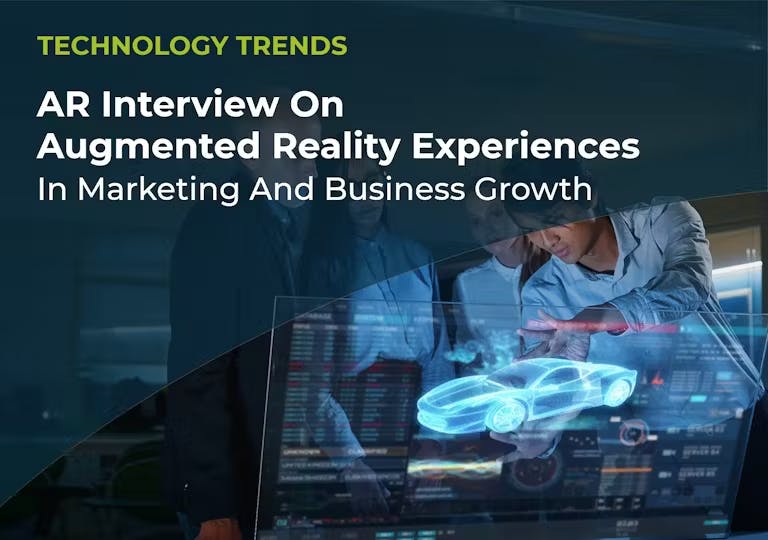AR Interview on Augmented Reality Experiences in Marketing and Business Growth


With new augmented reality (AR) information and devices being released often, it takes an expert to know the latest AR technologies and practices. That’s why we set up an interview with our mobile and AR professional, John Trujillo, here at Devsu. He has 10 years of education and experience in mobile development, plus award-winning projects built on that and his AR expertise.
“You need to know the information from the latest perspective of the technology, the practices, and everything else,” he explained as we set up our Q&A session. “Everything you know now could be antiquated.”
Answer all your questions on AR apps and other business uses for augmented reality in this interview with our mobile development engineer and AR connoisseur.
Read: Top 5 Trending Technologies in the IT Industry in 2022
What is Augmented Reality (AR)?
Let’s take a moment to go into what augmented reality is. At the detailed level, this technology is designed to overlay digital content in a real-world environment. In regular people's terms, when you preview furniture in your home, that’s a basic AR app. There are other differences between AR applications too. For example, in the furniture scenario, you’re in charge of lining it up where you want to envision it in the physical world. But if you’re using a filter on Snapchat or TikTok, those are marker-based AR apps—meaning it has to find your face, scan it, then overlay the filter to move with you in real-time.
Exclusive Interview with AR & Mobile Development Expert
Could you explain the difference between augmented reality (AR) and (VR)?
There is little difference between them, but they are different. With VR, you are getting into an immersive world in which you can see everything that’s 3D rendered that was previously created. You can listen to them and see them. In this case, you are getting out of the real world into this new world.
However, in augmented reality, you are not getting isolated from the world. You’re getting mixed reality. You’re seeing these 3D objects in your world. You are getting objects that cannot be there, but with augmented reality, they are there.
Out of curiosity, do you use artificial intelligence in AR?
For now, AI algorithms can be applied to visualize your work in augmented reality. But at the same time, as a developer, you cannot isolate it from that part of the process. This technology is not connected to AI, at least from a developer's perspective.
Thanks. Next, let’s talk about the most common or popular uses of AR and VR right now. Do you think it’s getting more popular?
Apple, Amazon, and others are allowing you to show the products you want in your home. For example, you could want to buy a chair. You can see the dimensions of that object inside your place. You have these opportunities to point out your product and not just see a static image, but a video.
With Facebook, for another example, you can interact with people in front of you. You can go to a bar or something like a movie or restaurant. Something like this, where you can go out with your friends from inside your house, and participate in different events and games inside this restaurant—there is this perspective that you can interact with different brands in the Metaverse and with people.
I think that’s the advantage of virtual reality. You can get the whole experience from a brand in a different way.
In Peru, one of the largest streets was covered with different advertisements. When you want to go to the beach, you need to get across all these streets. They would take pictures of the ads and see this different experience, where monsters were following you or these 3D objects were appearing. There were good results from this for the brand. You started feeling like you were not alone in this whole immersive experience. The brand was getting to interact with you. Plus, you wanted to go to the beach again just for the experience.
Brands are trying to give you more information in different ways, where you can enjoy the brand and the vision of the brand in a way that’s not intrusive. All the immersive ways you can have, this is something that businesses can profit from.
Aside from retail and marketing, do you think AR can have an impact in other areas (healthcare, etc.)?
In augmented reality, I haven’t seen something similar. But I think in the future, we could have something like sensors, which are getting more accurate. You can kind of have an appointment with your doctor and discuss your health and current measurements. We have gloves that let you touch and feel objects in different environments, but not more than that for now.
Would you advise brands to keep up with this technology to create better relationships with customers?
Yeah, especially with a brand. For example, let’s say you want your name in a script on top of your cake. In that case, you want to know what the dimensions and perspectives will be. Brands could use augmented writing, which allows you to do all this from your couch.
You’ll allow people to get into your brand and be with your clients in an easier way to give them exactly what they expect. You could have new products that people don’t know about, so it’s better to allow people to see your product.
I recommend brands get into these kinds of experiences because this is a new way to get into the houses and brains of people. You need to give new generations new ways to interact with your brand and get into what other competitors or bigger brands are doing.
Tell me about mixed reality and extended reality—are they in the same areas and uses of AR, or are they completely different?
I think mixed and extended reality are basically the same. The goal is to place a 3D object into the real world, but doing it with different technologies. Microsoft Glasses allow you to do this mixed reality, letting you interact with the object.
What about using AR and VR for educational purposes? Do you think that will take off in education?
There are tons of educational tools. The Google Earth application gets your position and shows you different stars or constellations. You’re learning astronomy, but you’re also learning geography because you can get information from across the world.
Now, teachers can show you 3D objects interacting with you in different ways. Other applications will show your hands and give you the ability to learn from physics. This immersive world can give you all of that in a way that you enjoy.
Should small businesses use AR?
For small businesses, there are tools that give you the opportunity to allow people to see your product or digitalize your menu or your experience.
There is an application called PolyCam. With it, if you want to sell a computer mouse, you just need to take a picture of it and post that. You are digitizing your product with a free account. You’re allowing people to see your product in a dimensional and simple way. With a paid account, you can get more products into the digital world.
Subscribe to our newsletter
Stay informed with the latest insights and trends in the industry
You may also like


